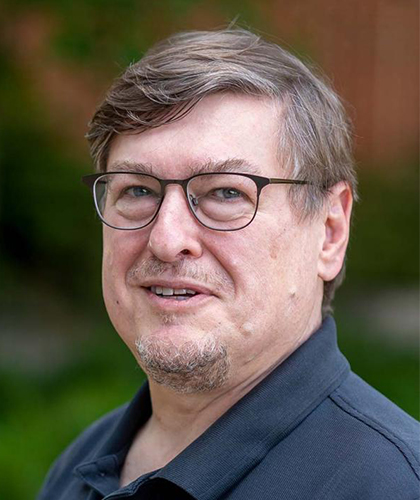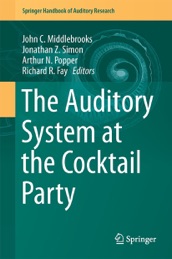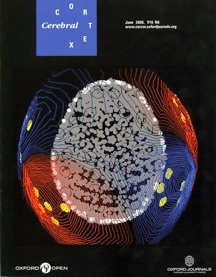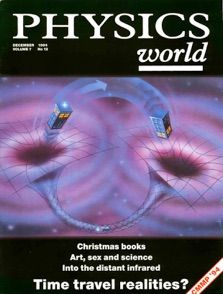
Simon, Jonathan
The Institute for Systems Research
Biology
Brain and Behavior Institute
Jonathan Simon's expertise is applied and theoretical neuroscience, with emphasis on auditory neuroscience. His research focuses on neural processing in the brain's auditory system, from specialized processing found only in humans (e.g., speech processing) to generalized processing found in most mammals, including auditory attention and sound localization.
He earned his bachelors in physics from Princeton University, his doctorate in physics from the University of California, Santa Barbara, and did postdoctoral research in theoretical general relativity (University of Wisconsin-Milwaukee, and University of Maryland-College Park) before embracing the field of neuroscience. He joined the University of Maryland's Electrical and Computer Engineering Department in 2001, the Biology Department in 2002, and the Institute for Systems Research in 2013. Simon is co-director of the KIT-Maryland Magnetoencephalography Center, and of the Computational Sensorimotor Systems Laboratory (CSSL).
My broad research goal is to understand how the auditory cortex processes complex sounds such as speech and other natural sounds. Because of my focus on speech and higher order processing, my research uses human rather than animal subjects. To non-invasively record and analyze real-time neural processing in humans, I use magnetoencephalography (MEG), because of its high temporal resolution (milliseconds), reasonable spatial resolution (millimeters), and silent operation. My primary research topics address the question of how the brain turns sound into hearing (surprisingly, the objective sounds impinging upon our ears are not very tightly linked to what we hear). Neural computations employ algorithms developed and fine-tuned by millions of years of evolution. As such the computations are typically far beyond the capability of even the most advanced computers. But by identifying, understanding, and quantitatively characterizing the computations performed by the brain, it is possible to determine those algorithms. This computational level of understanding has great potential benefits to engineering applications (e.g. auditory-based identification methods, robust speaker identification, robust speech processing) as well as to health-related applications (hearing aids and cochlear implants that would actually function well in a noisy environment). The class of neural computations that use the temporal character of the sounds being processed—those for which time plays an important role—are the primary focus of my research. This includes the neural computations employed in the processing of rhythmic sounds, e.g., speech or simple repeating patterns, and in the disentanglement of an individual rhythmic sound from other competing sounds.
Some of my main research areas are:
• Investigations of how the brain solves the “Cocktail Party” problem, i.e., how, in a crowded and noisy environment, we have the ability to hone in on a single auditory source (e.g. one person talking), while simultaneously suppressing all the remaining interfering sounds
• How the brain represents complex sounds such as human speech
• How the brain’s representations of complex sounds are built up from representations of much simpler building blocks (acoustic modulations)
• Advances in neural signal processing
Neuroscience Research
2018
• Brodbeck, C., L. E. Hong and J. Z. Simon (2018) Rapid Transformation from Auditory to Linguistic Representations of Continuous Speech, Curr Biol 28, 3976–3983. [PDF] [Daily Mail] [Eureka Alert] [Science Daily] [Neuroscience News] [Medical Xpress] [DoveMed] [Earth.com] [cnBeta][El Médico Interactivo] [Medical Xpress] [“Great Expectations” Dispatch]
• Cervantes Constantino, F. and J. Z. Simon (2018) Restoration and Efficiency of the Neural Processing of Continuous Speech are Promoted by Prior Knowledge, Front Sys Neurosci 12:56. doi: 10.3389/fnsys.2018.0005. [PDF] [Supplementary Material] [PMC]
• Miran, S., S. Akram, A. Sheikhatar, J. Z. Simon, T. Zhang and B. Babadi (2018) Real-Time Decoding of Auditory Attention from EEG via Bayesian Filtering, Conf Proc IEEE Eng Med Biol Soc. 2018:25-28. [PDF]
• Brodbeck, C., A. Presacco, S. Anderson and J. Z. Simon (2018) Over-Representation of Speech in Older Adults Originates from Early Response in Higher Order Auditory Cortex, Acta Acust united Ac 104(5), 774-777. [PDF]
• Miran, S., S. Akram, A. Sheikhatar, J. Z. Simon, T. Zhang and B. Babadi (2018) Real-Time Tracking of Selective Auditory Attention from M/EEG: A Bayesian Filtering Approach, Front Neurosci 12:262. [PDF] [Supplementary Material] [PMC]
• Vanthornhout, J., L. Decruy, J. Wouters, J. Z. Simon, and T. Francart (2018) Speech Intelligibility Predicted from Neural Entrainment of the Speech Envelope, J Assoc Res Otolaryngol 19(2) 181-191.[PDF] [PMC]
• Brodbeck, C., A. Presacco and J. Z. Simon (2018) Neural Source Dynamics of Brain Responses to Continuous Stimuli: Speech Processing from Acoustics to Comprehension, NeuroImage 172, 162–174. [PDF] [PMC]
• Puvvada, K. C., A. Summerfelt, X. Du, N. Krishna, P. Kochunov, L. M. Rowland, J. Z. Simon* and L. E. Hong* (2018) Delta Vs Gamma Auditory Steady State Synchrony in Schizophrenia, Schiz Bull 44(2), 378-387 *contributed equally [PDF] [Supplementary Information] [PMC]
2017
• Cervantes Constantino, F. and J. Z. Simon (2017) Dynamic Cortical Representations of Perceptual Filling-In for Missing Acoustic Rhythm, Scientific Reports 7(1), 17536. [PDF] [Supplementary Information] [PMC]
• Puvvada, K. C. and J. Z. Simon (2017) Cortical Representations of Speech in a Multi-talker Auditory Scene, J Neurosci 37(38), 9189-9196. [PDF] [PMC]
• Akram, S., J. Z. Simon and B. Babadi (2017) Dynamic Estimation of the Auditory Temporal Response Function from MEG in Competing-Speaker Environments, IEEE Trans Biomed Eng, 64(8), 1896-1905. [PDF] [Supplementary Files][PMC]
2016
• Presacco, A., J. Z. Simon and S. Anderson (2016) Effect of Informational Content of Noise on Speech Representation in the Aging Midbrain and Cortex, J Neurophysiol 116, 2356–2367. [PDF][PMC]
• Presacco, A., J. Z. Simon and S. Anderson (2016) Evidence of Degraded Representation of Speechin Noise, in the Aging Midbrain and Cortex, J Neurophysiol 116, 2346–2355. [PDF] [PMC]
[BBC Radio 4 Interview] [The Times] [Daily Mail] [Express] [Fast Company] [US News & World Report] [Deutsches Ärzteblatt] [Journal of Neurophysiology Podcast]
• Najafi, M., B. W. McMenamin, J. Z. Simon and L. Pessoa (2016) Overlapping Communities Reveal Rich Structure in Large-Scale Brain Networks During Rest and Task Conditions, NeuroImage 125, 92-106. [PDF] [PMC]
• Ding, N., J. Z. Simon, S. A. Shamma and S. V. David (2016) Encoding of Natural Sounds by Variance of the Cortical Local Field Potential, J Neurophysiol 115, 2389-2398. [PDF] [PMC]
• Senevirathna, B., L. Berman, N. Bertoni, F. Pareschi, M. Mangia, R. Rovatti, G. Setti, J. Simon and P. Abshire (2016) Low Cost Mobile EEG for Characterization of Cortical Auditory Responses, 2016 IEEE International Symposium on Circuits and Systems (ISCAS). p. 1102-1105. [PDF]
• Bertoni, N., B. Senevirathna, F. Pareschi, M. Mangia, R. Rovatti, P. Abshire, J. Z. Simon and G. Setti (2016) Low-power EEG monitor based on Compressed Sensing with Compressed Domain Noise Rejection, 2016 IEEE International Symposium on Circuits and Systems (ISCAS). p. 522-525.[PDF]
• Akram, S., A. Presacco, J. Z. Simon, S. A. Shamma and B. Babadi (2016) Robust Decoding of Selective Auditory Attention from MEG in a Competing-Speaker Environment via State-Space Modeling, NeuroImage 124, 906–917. [PDF] [PMC]
2015
• Chait, M., S. Greenberg, T. Arai, J. Z. Simon and D. Poeppel (2015) Multi-Time Resolution Analysis of Speech: Evidence from Psychophysics, Front Neurosci 9:214. https://doi.org/10.3389/fnins.2015.00214 [PDF] [PMC]
• Simon, J. Z. (2015) The Encoding of Auditory Objects in Auditory Cortex: Insights from Magnetoencephalography, Intl J Psychophysiol 95, 184–190. [PDF] [PMC]
2014
• Akram, S., B. Englitz, M. Elhilali, J. Z. Simon, and S. A. Shamma (2014) Investigating the Neural Correlates of a Streaming Percept in an Informational-Masking Paradigm, PLOS ONE 9(12): e114427. https://doi.org/10.1371/journal.pone.0114427 [PDF] [PMC]
• Akram, S., J. Z. Simon, S. A. Shamma and B. Babadi (2014) A State-Space Model for Decoding Auditory Attentional Modulation from MEG in a Competing-Speaker Environment, NIPS 2014 Advances in Neural Information Processing Systems 27, 460-468. [PDF]
• Ding, N. and J. Z. Simon (2014) Cortical Entrainment to Continuous Speech: Functional Roles and Interpretations, Front Hum Neurosci 8:311. https://doi.org/10.3389/fnhum.2014.00311 [PDF][PMC]
• Ding, N., M. Chatterjee and J. Z. Simon (2014) Robust Cortical Entrainment to the Speech Envelope Relies on the Spectro-temporal Fine Structure, NeuroImage 88 41–46. [PDF] [PMC]
2013
• Ding, N. and J. Z. Simon (2013) Robust Cortical Encoding of Slow Temporal Modulations of Speech, in Basic Aspects of Hearing: Physiology and Perception, B. C. J. Moore, R. D. Patterson, I. M. Winter, R. P. Carlyon and H. E. Gockel (Eds.), (Springer Verlag: New York), ISBN: 978-1-4614-1589-3. [PDF]
• Ding, N. and J. Z. Simon (2013) Adaptive Temporal Encoding Leads to a Background Insensitive Cortical Representation of Speech, J Neurosci 33(13), 5728-5735. [PDF] [PMC]
• Ding, N. and J. Z. Simon (2013) Power and Phase Properties of Oscillatory Neural Responses in the Presence of Background Activity, J Comput Neurosci 34(2), 337-43. [PDF] [Erratum] [PMC]
• Elhilali, M., S. Shamma, J. Z. Simon and J. B. Fritz (2013) A Linear System’s View to the Concept of STRFs, in Handbook of Modern Techniques in Auditory Cortex, Depireux, D. A. and M. Elhilali, M. (Eds.), (Nova Science Publishers: New York), ISBN: 978-1-6280-8894-6.
• Zion Golumbic, E. M., N. Ding, S. Bickel, P. Lakatos, C. A. Schevon, G. M. McKhann, R. R. Goodman, R. Emerson, A. D. Mehta, J. Z. Simon, D. Poeppel, and C. E. Schroeder (2013) Mechanisms Underlying Selective Neuronal Tracking of Attended Speech at a “Cocktail Party”, Neuron, 77(5), 980-991. [PDF] [Supplemental Information] [PMC]
[“Shaken, Not Stirred” Preview] [NPR interview] [Science Magazine News]
• Xiang J., D. Poeppel, and J. Z. Simon (2013) Physiological evidence for auditory modulation filterbanks: cortical responses to concurrent modulations, JASA Express Letters 133(1), EL7-EL12.[PDF] [PMC]
2012
• Ding, N. and J. Z. Simon (2012) The Emergence of Neural Encoding of Auditory Objects While Listening to Competing Speakers, PNAS, 109(29), 11854-11859. [PDF] [PMC]
• Wang, Y.*, N. Ding*, Ahmar N., Xiang J., Poeppel D., and J. Z. Simon (2012) Sensitivity to Temporal Modulation Rate and Spectral Bandwidth in the Human Auditory System: MEG Evidence, J Neurophysiol 107, 2033-2041. *contributed equally [PDF] [PMC]
• Ding, N. and J. Z. Simon (2012) Neural Coding of Continuous Speech in Auditory Cortex during Monaural and Dichotic Listening, J Neurophysiol 107, 78-89. [PDF] [PMC]
• Zhuo, J., S. Xu, J. Proctor, R. J. Mullins, J. Z. Simon, G. Fiskum, and R. P. Gullapalli (2012) Diffusion Kurtosis as an in vivo imaging marker for reactive astrogliosis in traumatic brain injury, NeuroImage 59(1) 467-477. [PDF] [PMC]
2011
• Jenkins, J., III, A. E. Rhone, W. J. Idsardi, J. Z. Simon, and D. Poeppel (2011) The Elicitation of Audiovisual Steady-State Responses: Multi-Sensory Signal Congruity and Phase Effects, Brain Topogr 24(2) 134-148. [PDF] [PMC]
2010
• Simon J. Z. and N. Ding (2010), Magnetoencephalography and Auditory Neural Representations, In Proc. Southern Biomedical Engineering Conference 2010, IFMBE Proceedings 32, K.E. Herold, W.E. Bentley, and J. Vossoughi (Eds.), 45–48. [PDF]
• Xiang J., J. Z. Simon and M. Elhilali (2010), Competing streams at the cocktail party: Exploring the mechanisms of attention and temporal integration, J Neurosci 30(36) 12084-12093. [PDF] [PMC]
• Chait, M., A. de Cheveigné, D. Poeppel and J. Z. Simon (2010) Neural dynamics of attending and ignoring in human auditory cortex, Neuropsychologia 48(11) 3262-3271. [PDF] [PMC]
• Elhilali, M., J. Xiang, S. A. Shamma and J. Z. Simon (2010) Auditory Streaming at the Cocktail Party: Simultaneous Neural and Behavioral Studies of Auditory Attention, in The Neurophysiological Bases of Auditory Perception, Lopez-Poveda, E. A., Meddis, R., and Palmer A. R. (Eds.), (Springer Verlag: New York), ISBN: 978-1441956859, 545-553. [PDF]
2009
• Carr, C. E., D. Soares, J. Smolders and J. Z. Simon (2009), Detection of interaural time differences in the alligator, J Neurosci 29, 7948-7956. [PDF] [PMC] [Journal Cover] [Journal Cover Description]
• Elhilali, M.*, J. Xiang*, S. A. Shamma and J. Z. Simon (2009), Interaction between attention and bottom-up saliency mediates the representation of foreground and background in an auditory scene, PLoS Biol 7(6), e1000129. *contributed equally [PDF][PMC]
2008
• Chait, M., D. Poeppel and J. Z. Simon (2008), Auditory Temporal Edge Detection in Human Auditory Cortex, Brain Research 1213,78-90. [PDF] [PMC]
• de Cheveigné, A., and J. Z. Simon (2008) Denoising based on spatial filtering, J Neurosci Methods 171(1), 331-339. [PDF] [PMC]
• Aytekin, M., C. F. Moss and J. Z. Simon (2008) A Sensorimotor Approach to Sound Localization, Neural Computation, 20, 603-635. [PDF] [Journal Cover]
• de Cheveigné, A., and J. Z. Simon (2008) Sensor Noise Suppression, J Neurosci Methods 168(1), 195-202. [PDF] [PMC]
2007
• Luo, H., Y. Wang, D. Poeppel and J. Z. Simon (2007) Concurrent Encoding of Frequency and Amplitude Modulation in Human Auditory Cortex: An Encoding Transition, J Neurophysiology, 98, 3473-3485. [PDF]
• Chait, M., D. Poeppel, and J. Z. Simon (2007) Human Auditory Cortical Processing Of Transitions Between ‘Order’ And ‘Disorder’, in Hearing – From Sensory Processing to Perception, Kollmeier, B., Klump, G., Hohmann, V., Langemann, U., Mauermann, M., Uppenkamp, S., and Verhey, J. (Eds.), (Springer Verlag: New York) 323-331. [PDF]
• de Cheveigné, A., and J. Z. Simon (2007) Denoising Based on Time-Shift PCA, J Neurosci Methods 165(2), 297-305. [PDF] [PMC]
• Chait, M., D. Poeppel and J. Z. Simon (2007) Stimulus Context Affects Auditory Cortical Responses to Changes in Interaural Correlation, J Neurophysiol, 98, 224-231. [PDF]
• de Cheveigné, A., J. Le Roux and J.Z. Simon (2007) MEG Signal Denoising Based On Time-Shift PCA, In Proc. ICASSP 2007 International Conference on Acoustics, Speech, and Signal Processing, Vol. I, 317-320. [PDF]
• Chait, M., G. Eden, D. Poeppel, J. Z. Simon, D. F. Hill and D. L. Flowers (2007) Delayed Detection of Tonal Targets in Background Noise in Dyslexia, Brain and Language, 102, 80-90. [PDF]
• Chait, M., D. Poeppel, A. de Cheveigné and J. Z. Simon (2007), Processing Asymmetry of Transitions between Order and Disorder in Human Auditory Cortex, J Neurosci, 27, 5207-5214. [PDF]
• Chait, M. and J. Z. Simon (2007) The dynamics of the Construction of Auditory Perceptual Representations: MEG Brain Imaging in Humans, In Reasoning and Cognition Interdisciplinary Series on Reasoning Studies Vol. 2, ed. D. Andler, Y. Ogawa, M. Okada, and S. Watanabe. (Keio University Press: Tokyo), ISBN: 4-7664-1332-6, 265-280.
• Simon, J. Z., D.A. Depireux, D. J. Klein, J.B. Fritz and S.A. Shamma (2007), Temporal Symmetry in Primary Auditory Cortex: Implications for Cortical Connectivity, Neural Computation, 19, 583-638. [PDF]
2006
• Luo, H., Y. Wang, D. Poeppel and J. Z. Simon (2006), Concurrent Encoding of Frequency and Amplitude Modulation in Human Auditory Cortex: MEG Evidence, J Neurophysiol, 96, 2712-2723. [PDF]
• Klein, D.J., J.Z. Simon, D.A. Depireux, and S.A. Shamma (2006), Stimulus-Invariant Processing and Spectrotemporal Reverse Correlation in Primary Auditory Cortex, J. Comput. Neurosci, 20(2), 111-136. [PDF]
• Chait, M. and J. Z. Simon (2006) The Dynamics of the Construction of Auditory Perceptual Representations: MEG Brain Imaging in Humans, In Reasoning and Cognition Interdisciplinary Series on Reasoning Studies Vol. 2, ed. D. Andler, Y. Ogawa, M. Okada, and S. Watanabe, 265-280.[PDF]
• Carr, C. E., S. Iyer, D. Soares, S. Kalluri and J. Z. Simon (2006), Are Neurons Adapted for Specific Computations? Examples from Temporal Coding in the Auditory System, In 23 Problems in Systems Neuroscience, ed. L. v. Hemmen and T. Sejnowski. Oxford, 245-265. [PDF]
2005
• Simon, J. Z. and Y. Wang (2005), Fully Complex Magnetoencephalography, J Neurosci Methods 149(1), 64-73. [PDF]
• Chait, M., D. Poeppel, A. de Cheveigné and J. Z. Simon (2005), Human Auditory Cortical Processing of Changes in Interaural Correlation, J Neurosci 35(37), 8518-8527. [PDF]
• Ahmar, N., Y. Wang and J.Z. Simon (2005) Significance Tests for MEG Response Detection, Neural Engineering, 2005. Conference Proceedings. 2nd International IEEE EMBS Conference on, 21-24. [PDF]
• Ahmar, N. and J.Z. Simon (2005), MEG Adaptive Noise Suppression using Fast LMS, Neural Engineering, 2005. Conference Proceedings. 2nd International IEEE EMBS Conference on, 29-32. [PDF]
• Wang Y., N. Ahmar, J. Xiang, L. Ma, D. Poeppel and J.Z. Simon (2005), Complex Valued Equivalent-Current Dipole Fits for MEG Responses, Neural Engineering, 2005. Conference Proceedings. 2nd International IEEE EMBS Conference on, 273-276. [PDF]
• Xiang, J., Y. Wang and J.Z. Simon (2005), MEG Responses to Speech and Stimuli with Speechlike Modulations, Neural Engineering, 2005. Conference Proceedings. 2nd International IEEE EMBS Conference on, 33-36. [PDF]
• Elhilali M., Klein D., Fritz J., Simon J. and Shamma S. (2005), The Enigma of Cortical Responses: Slow Yet Precise, in Auditory signal processing: physiology, psychoacoustics, and models, Pressnitzer D., de Cheveigné A., McAdams S. and Collet L., (Springer Verlag: New York), 485-494. [PDF]
2004
• Chait, M., J. Z. Simon and D. Poeppel (2004), Auditory M50 and M100 Responses to Broadband Noise: Functional Implications, NeuroReport 15, 2455-2458. [PDF]
• Elhilali, M., J. B. Fritz, D. J. Klein, J. Z. Simon and S. A. Shamma (2004), Dynamics of Precise Spike Timing in Primary Auditory Cortex, J Neurosci. 24, 1159-72. [PDF]
2003
• Grau-Serrat, V., C. E. Carr and J. Z. Simon (2003), Modeling Coincidence Detection in Nucleus Laminaris, Biol Cybern. 89, 388-96. [PDF] [PMC reader]
2001
• Simon, J. Z., S. Parameshwaran, T. Penney and C.E. Carr (2001), Temporal Coding in the Auditory Brainstem of the Barn Owl, in Physiological and Psychophysical Bases of Auditory Function, Ed.: D. J. Breebaart, A. J. M. Houtsma, A. Kohlrausch, V. F. Prijs, and R. Schoonhoven, Shaker: Maastricht. [PDF]
• Depireux D. A. , J. Z. Simon, D. J. Klein and S. A. Shamma (2001), Spectro-Temporal Response Field Characterization With Dynamic Ripples in Ferret Primary Auditory Cortex, J Neurophysiol 85,1220-1234. [PDF]
2000
• Klein, D. J., D. A. Depireux, J. Z. Simon and S. A. Shamma (2000), Robust Spectro-Temporal Reverse Correlation for the Auditory System: Optimizing Stimulus Design, J. Comput. Neurosci. 9, 85-111. [PDF]
• Kanlis N. A., J. Z. Simon, and S. A. Shamma (2000), Complete training analysis of feedback architecture networks that perform blind source separation and deconvolution, In Proc. Independent Component Analysis and Blind Signal Separation Workshop, ICA 2000, 139-144. [PDF]
1999
• Simon, J. Z., C. E. Carr and S. A. Shamma (1999), A Dendritic Model of Coincidence Detection in the Avian Brainstem, Neurocomputing 26-27, 263-269. [PDF]
1998
• Depireux, D. A., P. Ru, S. A. Shamma and J. Z. Simon (1998), Response-Field Dynamics in the Auditory Pathway, In Computational Neuroscience: Trends in Research, Ed: James M. Bower (Elsevier: Amsterdam) 263-270. [PDF]
• Depireux, D. A., J. Z. Simon and S. A. Shamma (1998), Measuring the Dynamics of Neural Responses in Primary Auditory Cortex, Comments Theor. Biol. 5, 89-118. [PDF]
• Simon, J. Z., D. A. Depireux and S. A. Shamma, (1998), Representation of Complex Dynamic Spectra in Auditory Cortex. In Psychophysical and Physiological Advances in Hearing. Ed.: A. R. Palmer, A. Rees, A.Q. Summerfield, and R. Meddis (Whurr: London) 513-520. [PDF]
Older Preprints
Physics Research
1997
• Jorma Louko, Jonathan Z. Simon, Stephen N. Winters-Hilt, Hamiltonian Thermodynamics of a Lovelock Black Hole, Phys. Rev. D 55 3525 (1997). [PDF]
1993
• Leonard Parker and Jonathan Z. Simon, Einstein Equations with Quantum Corrections Reduced to Second Order , Phys. Rev. D 47, 1339 (1993). [PDF]
1992
• John L. Friedman, N. J. Papastamatiou, and Jonathan Z. Simon, Failure of Unitarity for Interacting Fields on Spacetimes with Closed Timelike Curves, Phys. Rev. D 46, 4456 (1992). [PDF]
• John L. Friedman, N. J. Papastamatiou, and Jonathan Z. Simon, Unitarity of Interacting Fields in Curved Spacetime, Phys. Rev. D 46, 4442 (1992). [PDF]
• Jonathan Z. Simon, No Starobinsky Inflation From Self-Consistent Semiclassical Gravity, Phys. Rev. D 45, 1953 (1992). [PDF]
1991
• Jonathan Z. Simon, Stability of Flat Space, Semiclassical Gravity, and Higher Derivatives, Phys. Rev. D 43, 3308 (1991). [PDF]
1990
• Jonathan Z. Simon, Higher-derivative Lagrangians, Nonlocality, Problems, and Solutions, Phys. Rev. D 41, 3720 (1990). [PDF]
1989
• Robert C. Myers and Jonathan Z. Simon, Black Hole Evaporation and Higher-Derivative Gravity, Gen. Rel. Grav. 21, 761 (1989). [PDF]
1988
• Robert C. Myers and Jonathan Z. Simon, Black-hole Thermodynamics in Lovelock Gravity, Phys. Rev. D 35, 2434 (1988). [PDF]
1986
• J. Richard Gott III, Jonathan Z. Simon, and Mark Alpert, General Relativity in a (2+1)-Dimensional Space-Time: An Electrically Charged Solution, Gen. Rel. Grav. 18, 1019 (1986). [PDF]
1998
• Jonathan Simon, Learning Physics From Science Fiction, Physics World 11:1, 52 (1998). [PDF]
1994
• Jonathan Z. Simon, The Physics of Time Travel, Physics World 7:12, 27 (1994). [PDF] [Journal Cover]
1992
• Bruce Allen and Jonathan Simon, Time Travel on a String, Nature 357, 19 (1992). [PDF]
Live Searches for Simon publications
via Google Scholar
via PubMed
via inSPIRE




